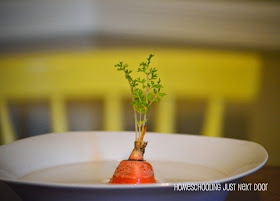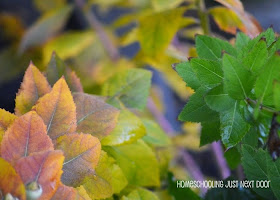Admittedly, botany has grown on me (no pun intended). Each time I have taught a unit on botany, my intrigue has grown. Watching plants literally grow before your eyes, examining some of the individual parts up close, and learning how plants function has become a real interest of mine. As my interest piqued, so did my desire to foster a love of botany in my children.
One way I have employed is hands on learning. What follows is a listing of botany experiments and activities we have done (successfully, for the most part) in our own home.
Growing & Dissecting Seeds
Using dry kidney beans from the store, a snack-size plastic bag, water, and a paper towel, we were able to watch the beans sprout. These were hung with painter's tape on a wall.
Later, using some beans from the same bag, we soaked beans for a few nights in a bowl of water. Then, we cut open the beans to identify the different parts of a seed (seed coat, hilum, food supply, embryo)
Observing & Growing Roots

Aside from simple observations of fibrous and tap root systems, we like to observe roots forming.
Typically, we have some jar or bottle filled with water and a leaf clipping somewhere in our kitchen. It is an observation we continually try with varying success (all depends on the clipping and the type of plant).
However, for the first time, this year, we attempted to grow a plant from part of a carrot. It worked!
Observing Stems
This is another repeat experiment for us. In an effort to observe how stems help transport water and minerals, we placed a celery stalk in colored water. (We've found blue is the best color with clearest results.)
Observing & Studying Leaves
Leaves are one of the easiest parts of a plant to observe. On many nature walks, or even in our own backyard, we've discovered amazing leaves. In the past, we've collected, compared, measured, and pressed leaves.
Something new we tried this year was to remove chlorophyll from the leaves. It was autumn, and we could easily see the leaves losing their greenness.
Deciding to remove the chlorophyll was easy. Figuring out exactly how was harder. We tried several methods. The two that seemed to work best were a scratching method and a boiling procedure. For ideas on how to remove chlorophyll go here.
Dissecting Flowers
In a previous post, I shared how my co-op students fashioned paper flowers. This served as a review to the previous class, which was dissecting a flower.
During the first co-op class on flowers, I taught the students the parts of a flower. Using a fill-in-the-blank worksheet and white board, the students learned various parts of the flower. We then spent the rest of the class dissecting real flowers (pictured above pre-dissection). We used information from here and here, but ultimately, I had to create our own hybrid documents and procedure tailored to our students. An alternative is a virtual lab found here or here.
Growing a Garden
One of the most simple botany activities to do is to grow something from a seed. For numerous years, we have grown, or attempted to grow, some of our own vegetables and spices. Our family has gained a better understanding of plants
Collecting & Pressing Flowers & Leaves
This is such an easy project to do with smaller children, but one that older students may enjoy as well. It is certainly one hands on activity we have done through the years multiple times.
Having curious children is easy. Directing their curiosity toward creation is even easier. It seems to me, that children are naturally drawn to their natural surroundings. Whether a walk at a park, on a beach, in a woods, or in your own backyard, there is an interesting plant to be seen.
Fruit

Almost every year we go to the orchard and pick fruit. Though it is not our sole intention to study the fruit on the tree or vine, it is remarkable how much we observe about fruit during these visits. This year, as with most things plant related, we opted to dissect fruit. We cut apart bananas, apples, pineapples, and strawberries, all which we ate afterwards.
For more botany lesson ideas and activities:




















No comments:
Post a Comment